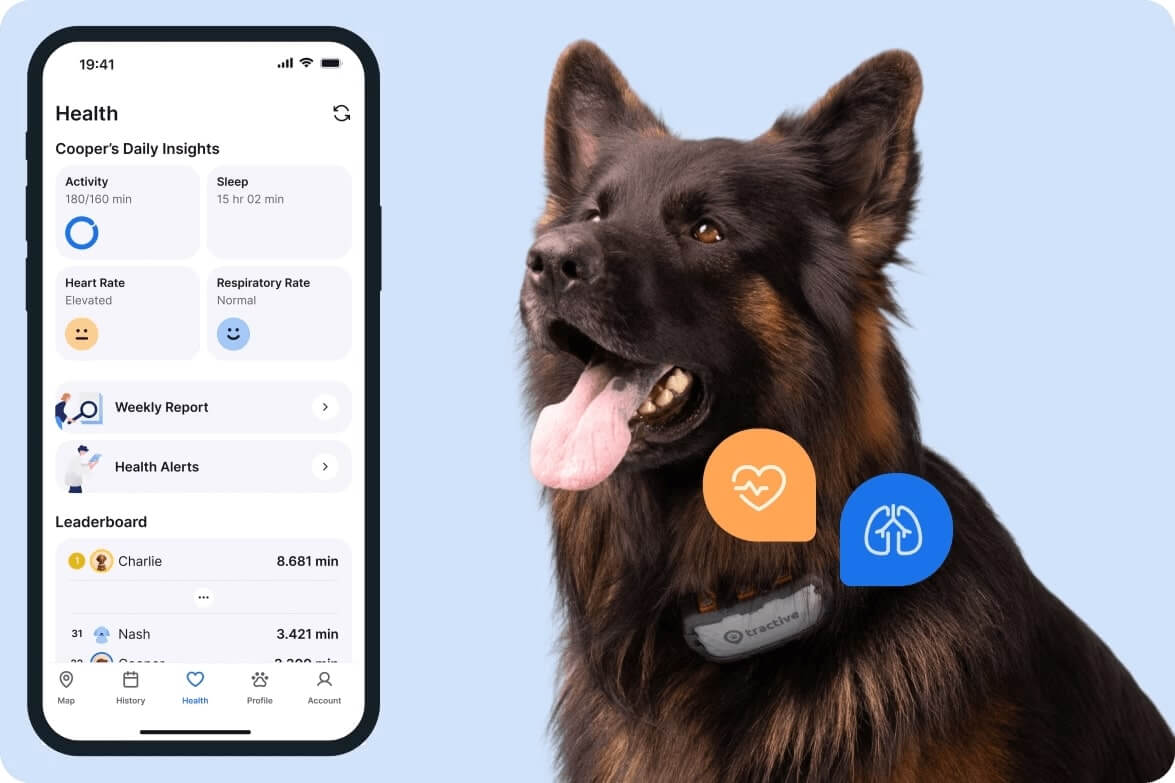 Approved by Dr. Dwight Alleyne, DVM
Approved by Dr. Dwight Alleyne, DVM 9 Dog Sleeping Positions & What They Mean
Dogs, like us, can sometimes have funny sleeping behavior. Learn all about the most common dog sleeping positions and how dogs sleep in general in this article.
Dogs often sleep in odd positions. It could be due to the room temperature, how active they are, how they’re feeling and how much they trust you. But have you ever wondered – why does your dog sleep that way? In this post, we’ll explore the mysteries of several dog sleeping positions – and what they can tell you about how well your dog’s sleeping.
Key Takeaways
Sleeping positions can reveal a dog’s emotional state and health
A dog’s sleeping position can be a form of body language. It can indicate their comfort level, trust, or even a health issue.
Various positions have different meanings
For example, the side sleeper (deep sleep and trust), the lion’s pose (a quick nap), and the belly-up position (feeling hot or very trusting).
Changes in sleep patterns can signal health issues
Sleeping more than usual or in unusual positions can be a sign of illness. Some positions, like sleeping with an elevated head, may indicate a serious condition.
A Tractive smart dog tracker with Sleep Tracking can help
Your Tractive device comes with a built-in motion detector to monitor a dog’s sleep patterns. This can help you detect unusual changes early and have a more productive conversation with your vet.

Always know your buddy is healthy & safe
Read moreDog sleeping behavior: Understanding the basics
Being a dog is a lot of work. You have to go for walks, fetch sticks, and be alert for subtle changes in your people. As a result, dogs need about 10-14 hours of sleep per day. This includes nighttime sleep plus a few daytime naps.
However, dogs can adapt their sleeping behavior to their surroundings. Meaning, they can be awake when there is something to do, and asleep the rest of the time. Some indoor dogs may even sleep too much because they’re bored!
5 quick dog sleeping facts
- Dogs experience different stages of sleep (REM & NREM), just like we do. So if they bark, whine, or jerk their legs during REM sleep, it’s possible it’s because they’re dreaming – likely of you!
- 60% of all dog bites happen to children when they try to wake a dog in a deep sleep.1
- Most dogs walk around in a circle before lying down (they are displaying an ancestral tendency, which is basically a way to get comfortable and feel safe).
- Puppies and older dogs dream more than middle-aged dogs.
- Most importantly: if your dog sleeps more than normal, this could be a sign of illness in your canine friend. Contact your veterinarian if you suspect your dog is sleeping too much.
💡So with a Sleep Tracker for dogs, you can figure out right away if your dog’s sleeping more or less than usual – which could signal they might be sick or in pain. (Which we’ll cover a little further below.)

Get health alerts for your dog
Our pups can’t always tell us if something’s wrong. But if their tracker detects unusual changes in their routine, you’ll get an alert, helping you catch potential issues early.
Common dog sleeping positions
1) The side sleeper
A dog sleeping on their side with legs extended is getting some serious deep sleep. When you find your dog in this sleeping position, leave them alone to get a prolonged period of restorative rest. You might notice that your dog chooses to sleep in a dog bed or on your bed for this deep sleep, and usually choses a spot away from the busiest areas of your home. Side sleeping conveys that your dog feels comfortable in their environment and trusts you.
2) The lion’s pose
When your dog sleeps with their head resting on top of their front paws, a position known as lion’s pose, they’re just taking a minute to doze off. Your snoozing dog is ready to leap into action at a moment’s notice from this sleeping position. You may observe that your dog nods off in a lion’s pose while sitting at your feet or near the front door, where they can be close to any potential action while sneaking in a short nap.
3) The donut sleeping position
Curled into a tight little ball, a dog in the donut sleeping position has all of their limbs tucked close to the body and may rest their nose on their hind legs. The tail may be draped over the body like a fluffy scarf. Dogs sometimes choose the donut position to conserve body heat, so you may see your dog in this position more often in cold weather.
- Some dogs choose the donut position for sleeping if they feel vulnerable or anxious. They are keeping their vital organs covered up, rather than exposing their stomach. This sleeping position is a remnant of your dog’s wild ancestor’s need to protect themselves from predators at all times, but especially when sleeping.
- Dogs who are getting used to a new home or other big life changes may sleep in the donut position as they adjust to their new circumstances. The donut sleeping position offers a feeling of safety and comfort.
4) Sleeping under the covers
Are you the owner of an “undercover” sleeper? This sleeping position may just be a matter of preference. If your dog burrows under the covers, it can signal a need to feel companionship while sleeping. Going under the covers is more common in cold weather, when even us humans want to stay snuggled up as much as we can.
5) Back-to-back sleeping position
If your dog sleeps back-to-back with you or another dog, they are exhibiting trusting behavior and intimacy. Back-to-back sleeping may echo dogs’ ancestral pack behavior, when entire families slept piled together in dens. Or it may remind your dog of their first weeks of life, when they lay tumbled in an adorable furry heap with its littermates.
If you are the only family member that your dog chooses to sleep against, this means you are the lucky one whom the dog trusts the most! Be glad that your dog places so much trust in you and treasure the bond that you have.
6) The Superman sleeping position
Sprawled on the ground with front legs pointed forward, back legs pointing behind, and tummy pressed to the floor, your sleeping dog may remind you of Superman in flight. When in the Superman position, your dog is probably worn out from a day of very active play.
But don’t be fooled by this lazy-looking posture – just like the real Superman, your dog is ready to spring into action in the blink of an eye if a family member needs them. No costume change is required for this furry Superman!
7) Dog sleeping on back: The belly-up sleeping position
Why does your dog sleep on their back with their legs in the air? Dogs who sleep belly-up with legs pointed to the sky are either very hot or very trusting (or both).
- By exposing the tummy, which has less fur, the dog may be able to cool off quickly. The belly-up pose can also be a seasonal sleeping position for your dog. You’ll notice it more often in hot weather.
- But baring the belly allows the vital organs to be exposed and makes the dog feel more vulnerable.
So if your dog sleeps in this extremely cute position, definitely take a picture and know that your dog is super comfortable around you.
8) The snuggle-bug
If your dog immediately leaps onto your lap whenever you sit down or cuddles up against you you on the sofa, you’ve got a snuggle-bug. These cuddlers are affectionate, loving, and maybe a little needy. If you have a very large dog, cuddling with your snuggle-bug can be a challenge, but you can enjoy knowing that you have won your furry friend’s trust and devotion.
9) Sleeping with the head elevated
Some dogs prefer to sleep with their head and neck raised above the level of the body. This could signal that your dog has difficulty breathing properly and could have heart disease or other conditions.
Pay close attention to a dog that sleeps with their head and neck elevated. Watch for noisy or rapid breathing, or an inability to participate in normal exercise. Contact your veterinarian and report any symptoms you’ve noticed.

Where a smart dog tracker can be a lifesaver
While you’re away or asleep, it can be difficult to spot a change in your dog’s sleeping positions – or whether they’re sleeping more or less than usual. But in some cases, tracking your dog’s sleep data can even save their life. Especially if it helps you catch on to a canine sleeping disorder, like:
- Sleep apnea, most common among large and/or overweight dogs. Snoring and disordered breathing can prevent your dog from getting a good night’s sleep.
- Insomnia, which could be due to chronic pain, illness, or even a UTI.
- Narcolepsy, which is a nervous system sleep disorder where your dog suddenly falls asleep – even in the middle of an activity.
💡So with a smart dog tracker strapped to their collar, you can share actionable data on your dog’s sleep patterns with your vet – and catch on to a dip in your dog’s health before it has a chance to worsen. Here’s how your trusty Tractive device helps you monitor your dog’s sleep.

With its built-in motion detector, your tracker monitors your dog’s movements throughout the day – both when they’re on the move, but also on the snooze. So, with time, you can figure out:
- How much sleep your dog gets on the regular,
- How much quality sleep your dog gets on the regular – including how many times they were disturbed mid-sleep,
- If there’s a weird spike or drop in your dog’s sleep minutes, which could signal a health problem.
Which can help you spot a health issue early, get your dog to a vet – and potentially save their life, while at it!
Your furry friend’s health and wellbeing means as much as to us as it does to you. So we’ve made it a priority to only share medically-relevant content on our blog. This post was checked, double-checked, and medically verified by Georgia-based vet, Dr. Dwight Alleyne.

Dr. Dwight Alleyne, DVM
Originally from Long Island, New York, Dr. Alleyne began his career at a no-kill animal shelter before becoming a licensed veterinary technician. He graduated from Cornell University Veterinary College in 2006 and completed an internship at Purdue University. Now practicing in Georgia, Dr. Alleyne specializes in soft tissue surgery and ultrasounds. He also writes pet health articles on his website, “The Animal Doctor Blog” (www.anmldrblog.com).



